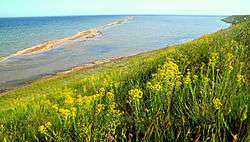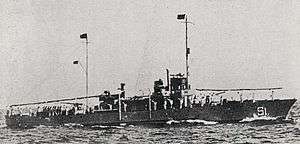Burnas Lagoon
| Burnas Lagoon | |
|---|---|
 The coast of the Burnas Lagoon near the village of Tuzly | |
 The Burans Lagoon on the schematic map of the Tuzly Lagoons (#1) | |
| Location | Black Sea |
| Coordinates | 45°50′N 30°07′E / 45.833°N 30.117°ECoordinates: 45°50′N 30°07′E / 45.833°N 30.117°E |
| Ocean/sea sources | Atlantic Ocean |
| Basin countries | Ukraine |
| Max. length | 7 km (4.3 mi) |
| Max. width | 1–3 km (0.62–1.86 mi) |
| Salinity | ~30 ‰ |
| Settlements | Lebedivka, Tuzly |
Burnas Lagoon (Ukrainian: Бурнас, Romanian: Limanul Burnas) is a marine lagoon (or liman), located in southern Ukraine in Tatarbunary Raion of Odessa Oblast. The salinity of the lagoon is two times higher than in the Black Sea. The lagoon is connected to the sea via a system of canals. The lagoon is about 7 km long and 1–3 km wide. In the northern part the lagoon is connected to the lagoon Solone Ozero, in the north west to the Kurudiol Lagoon. The source of the lagoon water is the Black Sea and the river Alkaliya, which inflows to the lagoon Solone Ozero.
The peloid health spa Lebedivka is located on the northern coast of the Burnas Lagoon.
The coasts of the lagoons are used by many species of birds for nesting. The system of Sasyk Lagoons — Shahany — Alibey — Burnas has the status of an International wetland reserve.
World War II
| Burnas Naval Campaing | |||||||
|---|---|---|---|---|---|---|---|
| Part of the Black Sea Campaigns of the Eastern Front of World War II | |||||||
 Romanian gunboat Stihi Eugen | |||||||
| |||||||
| Belligerents | |||||||
|
|
| ||||||
| Strength | |||||||
|
1 destroyer 1 torpedo boat 2 gunboats 1 flying boat | 5 submarines | ||||||
| Casualties and losses | |||||||
| 1 transport ship sunk |
1 submarine sunk 1 submarine damaged | ||||||
In late 1942, during World War II, the coast of the lagoon was the location of several naval engagements.
On 16 and 19 September, the Soviet Leninets-class submarines L-5 and L-4 laid mines off the lagoon's coast.[1]
On 1 October, the Soviet M-class submarine M-118 attacked and sank the German transport ship Salzburg. After attacking, the submarine was located by a German BV138C flying boat, and the Romanian gunboats Sublocotenent Ghiculescu and Stihi Eugen were sent to the scene. The two Romanian warships attacked the submarine with depth charges, sinking her with all hands.[2][3][4]
On 14 October, the Soviet submarine M-32 unsuccessfully attacked the Romanian destroyer Regele Ferdinand near the lagoon, the submarine being subsequently depth charged and damaged by the Romanian torpedo boat Smeul.[5][6]
On 26 December, the Soviet submarine M-111 unsuccessfully attacked a Romanian convoy consisting of two transport ships.[7][8]
References
- ↑ Donald A Bertke, Gordon Smith, Don Kindell, World War II Sea War, Volume 7: The Allies Strike Back, p. 70
- ↑ Antony Preston, Warship 2001-2002, pp. 79-80
- ↑ Donald A Bertke, Gordon Smith, Don Kindell, World War II Sea War, Volume 7: The Allies Strike Back p. 179
- ↑ Mikhail Monakov, Jurgen Rohwer, Stalin's Ocean-going Fleet: Soviet Naval Strategy and Shipbuilding Programs 1935-1953, p. 266
- ↑ Donald A Bertke, Gordon Smith, Don Kindell, World War II Sea War, Volume 7: The Allies Strike Back, p. 179
- ↑ Antony Preston, Warship 2001-2002, pp. 79-80
- ↑ Donald A Bertke, Gordon Smith, Don Kindell, World War II Sea War, Volume 8: Guadalcanal Secured p. 77
- ↑ Antony Preston, Warship 2001-2002, pp. 79-80